What is a DAG? Directed Acyclic Graphs
One of the main engineering challenges in the blockchain space is scalability.
Scalability refers to the development of technologies or protocols that can handle more transactions in a given amount of time.
While traditional payment networks like Visa can handle thousands of transactions per second, most blockchains can only handle a handful of transactions in the same period of time. This is due to their decentralized nature.
All nodes on the network process all the transactions in parallel. This means, the least performant node is the limiting factor for the overall performance of the network.
In order to maintain a high level of decentralization, a large node count is important, hence raising the minimum requirements for nodes is problematic, if they are not rewarded accordingly.
This comparison is unjust, in that Visa itself can be viewed as a third or fourth-layer technology:
International Bank of Settlements > National Central Bank > Retail Bank > VISA. There is still a significant difference in performance that needs to be addressed.
The Scalability Challenge
The main factors affecting a blockchains protocol scalability regarding transaction throughput are:
- The size of a single transaction (byte)
- The block size (byte -> transactions per block)
- Block time, the interval in which blocks are created (time -> blocks per time unit -> transactions per time unit)
- Propagation delay on the network (seconds)
To increase the throughput of a linear blockchain on the protocol level one can either decrease the size of transactions themselves or the interval in which blocks are created. Another option would be to increase the block size.
This can be shown with Bitcoin as an example. Whereas Bitcoin activated SegWit to decrease the size of individual transactions, the closely related Litecoin protocol on the other hand, reduced the block interval from 10 to 2.5 min. Bitcoin Cash went the other way and decided to increase the block size.
The problem is the following:
Transaction size can only be decreased by so much, as transactions are quite compact already.
Even if you could shrink a transaction to a tenth of its size, this would only increase throughput from 7 to 70 transactions per second for Bitcoin. Not exactly Visa level.
Raising the block size limit comes at the expense of mining centralization, as fewer people can compete in the competitive mining industry when hardware and network requirements increase.
Decreasing the block interval leads to more orphaned blocks and is limited by network synchronization time across the globe.
An increase in block size also increases the orphan rate because propagation time is increased linearly with it.
A high rate of orphaned blocks reduces the overall security of the protocol, because honest hash power is “wasted” and does not contribute to the security of the ledger.
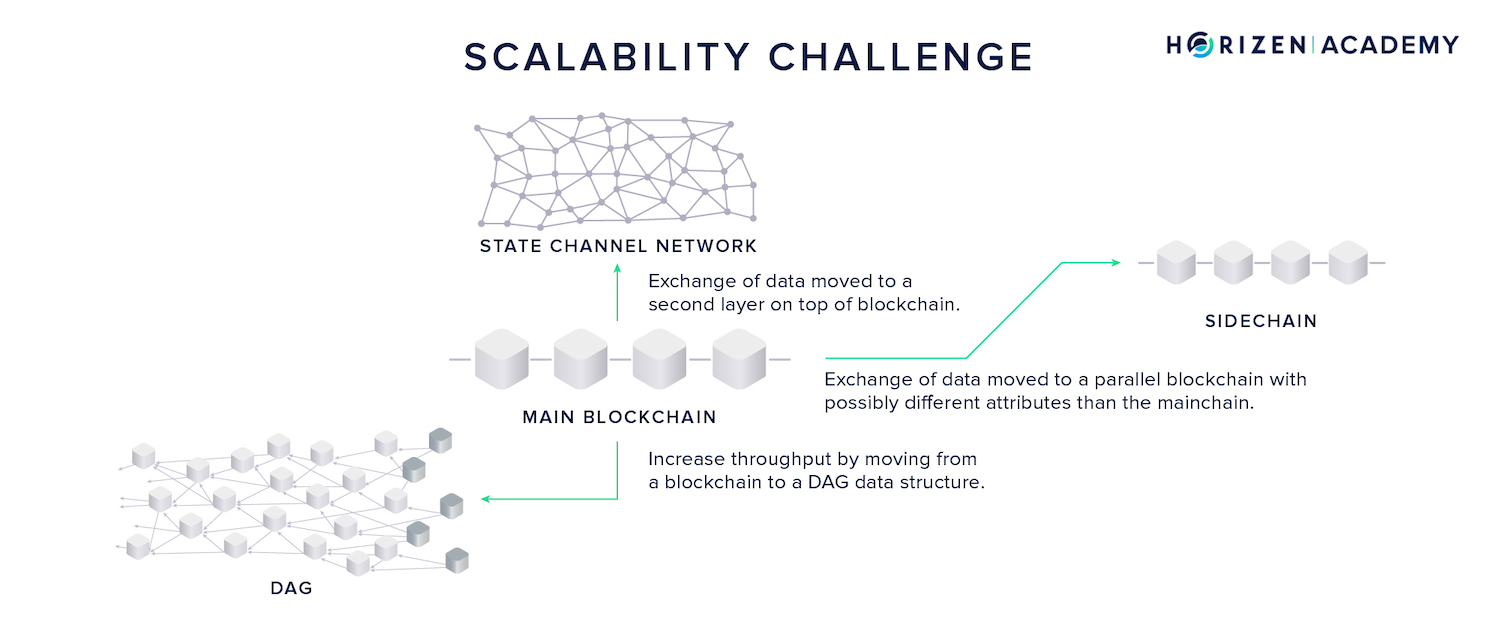
There are generally three approaches to scalability:
- Second-layer technologies like payment or state channels which are used in the Lightning Network that take transactions off-chain with the option to settle on-chain at any time.
- Sidechain approaches, which can best be described as a parallelization of blockchains. Assets can be transferred from one chain to another via a two-way peg (2WP) and the transactional load is shared between the mainchain and its sidechains.
- Directed acyclic graphs (DAGs) have a different data structure than blockchains. Many blocks can be produced in parallel which requires modifications to the consensus mechanism.
What is a DAG?
The term DAG stands for Directed Acyclic Graph. Strictly speaking, a DAG is a mathematical concept and nothing particularly innovative in and of itself.
The structure on the left in the image below is a graph made up of nodes, or vertices, and edges connecting the nodes.
In a directed graph, each connection, or edge, has a direction, as indicated by the arrows in the image in the center.
A directed acyclic graph does not allow cyclic relationships between nodes, like the one you can see in the diamond-shaped part of the directed graph in the middle. In technical terms, one would say the Graph G = (V, E) is defined as the set of vertices V and edges E.
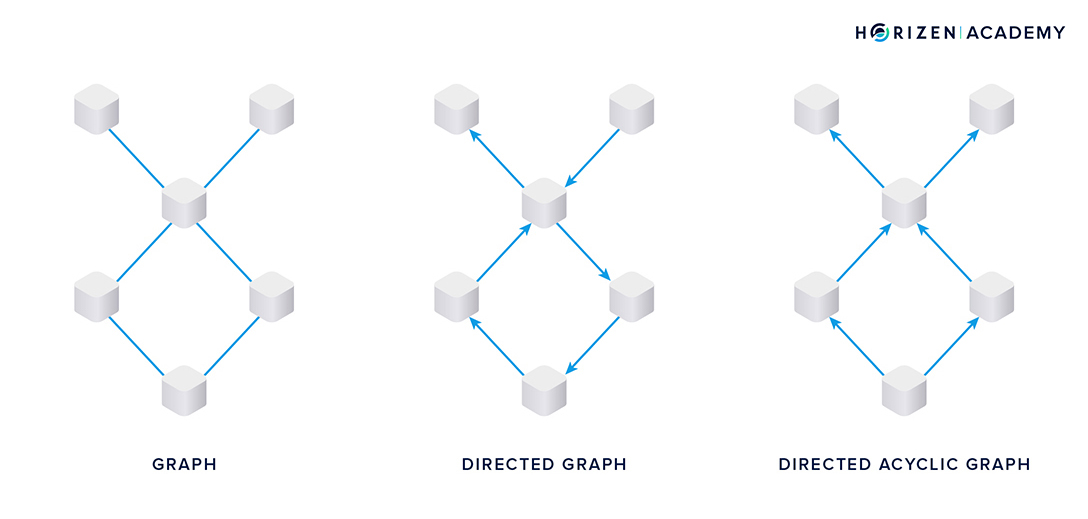
Technically, a blockchain is the most simple form of a DAG.
It is a linear structure of nodes, the blocks, and edges, the references, that have a direction and no cyclic relationships.
The innovation introduced with Bitcoin and blockchain technology was achieving consensus and Sybil-resistance in a decentralized environment.
This innovation can be applied to different, more sophisticated data structures as well.
“Both Blockchains and DAGs are digital ledgers. Both may be distributed. Both may be decentralized. Both may have token-economic incentive-mechanisms. They are both subject to immutability attributes as defined by their networks/communities. And finally each network is comprised by its constituents, including users, devs, miners, and other stakeholders” - Bunny Hernandez
There are two different ways to set up a DAG to be used for a cryptocurrency.
The nodes can comprise of individual transactions, or they can be blocks containing a number of transactions. The first notable DAG protocol was IOTA’s Tangle.
In Tangle, each node is made up of a transaction. Each transaction references two prior transactions and has a small Proof-of-Work attached to it.
Horizen is evaluating the use of a Block-DAG protocol.
Each node in the DAG is a block, and a block in the Block-DAG is similar to a block in a blockchain. A Block in a DAG also has a block header and contains a number of transactions, just as a block in the blockchain does.
The block header contains important information like a timestamp and references to previous blocks as well as a set of transactions.
Miners mine the block, meaning they attempt to solve an intensive computational task based on choosing an initial random number. The miner that solves the task first gets to create the next block in the chain, therefore deciding the order of transactions.
This method of the network coming to a consensus on the order of transactions is the same that is used by most blockchains, namely Proof of Work.
The main difference when compared to a block in a blockchain, is that a block in the Block-DAG can contain references to more than one predecessor, while each block in the blockchain always references the previous block.
Miners don’t have to choose a single block to reference, but instead include references to all previously unconfirmed blocks, the leaves of the DAG.
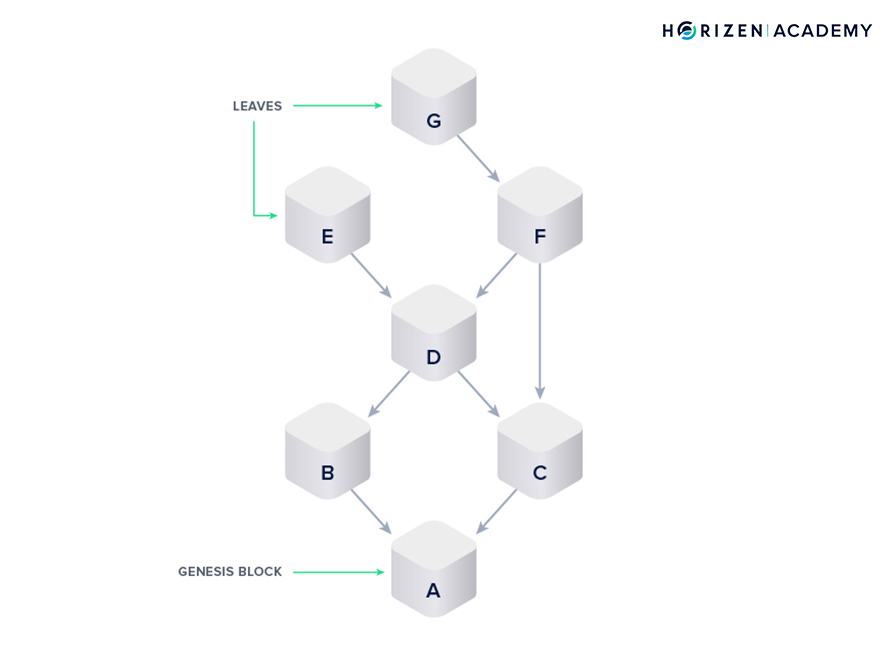
Assuming that both types of blocks contain the same number of transactions, just by looking at the graphic below, it is intuitive that the DAG will process more transactions in a given period of time than the blockchain does.
There is more storage capacity in the Block-DAG compared to the blockchain.
The DAG introduces two-dimensionality to the otherwise linear or one-dimensional data structure of the blockchain and is a promising approach to make decentralized networks scale. We only change the data structure compared to a blockchain but keep the same consensus mechanism, Proof-of-Work, to have the network agree on a single transaction history.

Consensus vs. Sybil Resistance
We would like to introduce a distinction between consensus mechanisms and Sybil-resistance mechanisms.
You've come across the term Proof-of-Work (PoW), and most likely Proof-of-Stake (PoS) or Proof-of-something labeled as consensus mechanisms before.
PoW and its relatives are actually Sybil-resistance mechanisms.
In a Sybil Attack, a malicious party creates a large number of centrally controlled online identities and tries to achieve certain, mostly malicious, goals by exerting influence through these fake identities.
Online voting is the most intuitive example of a situation where many fake identities can be used to game the results.
Sybil-resistance mechanisms prevent this by tying the voting power of an entity to a scarce resource that is harder to obtain than fake user-accounts or IP-addresses.
In Proof of Work, the scarce resource voting power is tied to is computational power. Your voting power is the share of computing power you control, relative to the total computing power of the network.
In Proof of Stake, your voting power is tied to the share of native currency you own, relative to the circulating supply on the network, or more precisely, to the actual staked supply on the network.
While these mechanisms prevent malicious actors from exerting undue influence on the network, they don’t help to achieve consensus on a single transaction history by themselves.
This is what the actual consensus mechanism does. In most cases this is the longest chain rule or heaviest chain rule, also called Nakamoto Consensus.
The term heaviest chain rule is more precise, as the rule is defined by the amount of aggregated work that went into building a branch, rather than the number of blocks. Theoretically, there could be a fork with two branches, where the shorter branch has more aggregate work to it.
In this case, the shorter branch would be considered valid. In practice, this does not make much of a difference because there is little variety in the PoW attached to blocks on major blockchains. This little excursion should prove valuable to following along on a history of Block DAG protocols.
Block DAGs
Note: There are no production block DAG protocols live today. We look to lay out the considerations that go into building such a protocol, rather than the actual implementation details.
GHOST
One of the first steps towards Block-DAG protocols was the Greedy Heaviest Observable Sub Tree Protocol, or the GHOST Protocol. The consensus mechanism in GHOST is not based on the longest chain rule.
Instead, the subtree with the greatest combined Proof-of-Work or difficulty is considered the valid branch by protocol design.

A more intuitive description might be finding the subtree of greatest cardinality. Here we make the same assumption as before when distinguishing between the longest and heaviest-chain rule.
The structure on the image above is moving into DAG territory, rather than just being a blockchain with orphaned blocks, though there is no such clear distinction.
Technically, it is still a tree and not a DAG though.
The two differ in trees being able to branch off in the direction of the edges, but branches not merging together later on. DAGs, on the other hand can do both, branch off and merge.
Trees are a subcategory of DAGs, in that every tree is a DAG, but not every DAG is a tree.
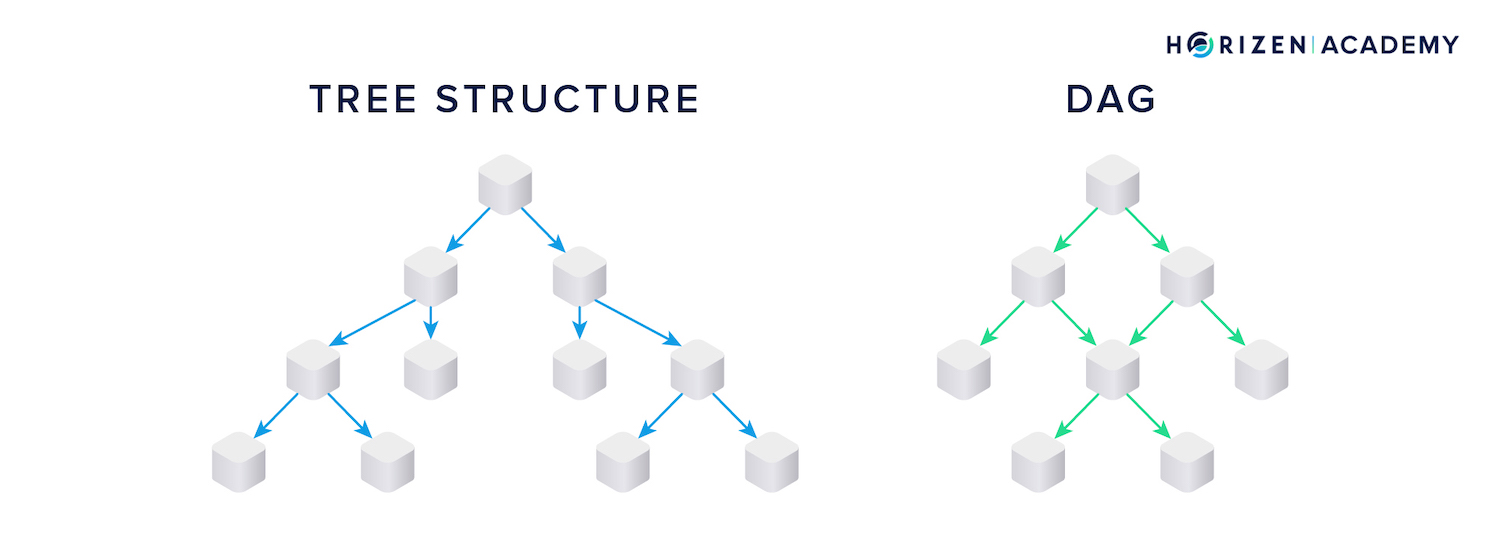
Earlier, we said decreasing the block time and increasing the block size leads to a higher orphan rate and reduced security.
In GHOST, this effect is eliminated by introducing a different mechanism to elect valid forks. An attacker would also need to control more relative hash power to perform double spends (>51%) than he would need to with the longest chain rule (51%) as the consensus mechanism.
“Each of these mechanisms share similar quantitative notions of a block's aggregate proof of work/hash power but differ qualitatively: aggregate chain work vs aggregate subtree work.” - Drew Stone
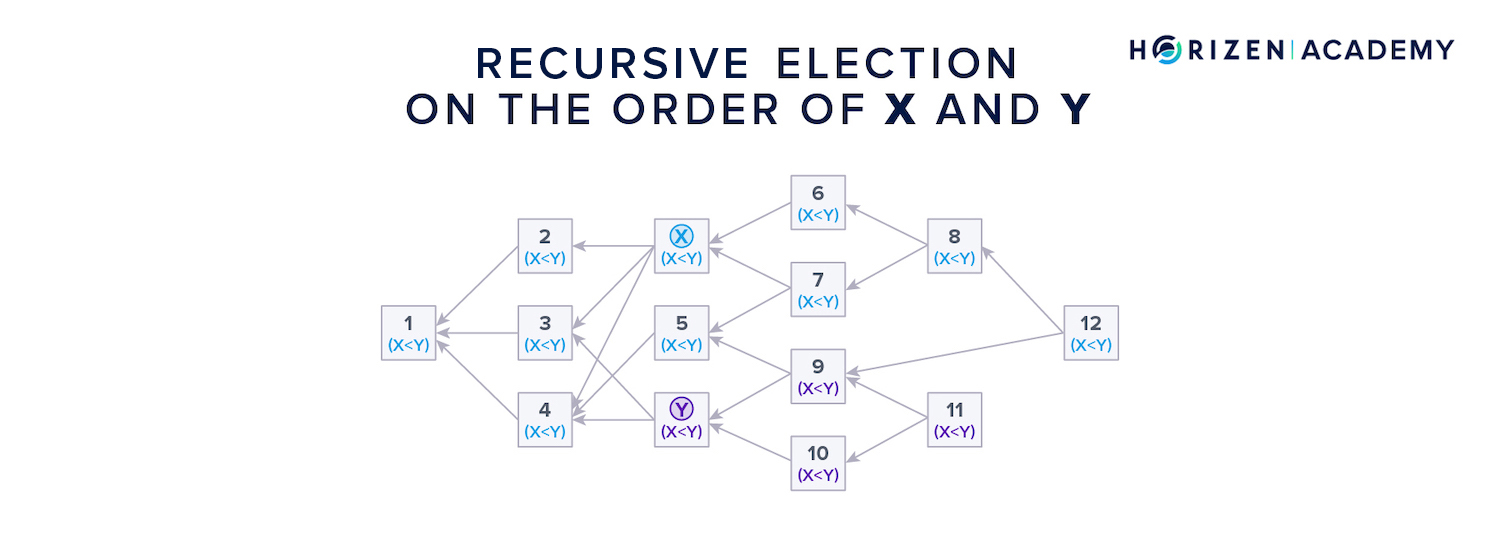
SPECTRE
Another evolutionary step in the development of a Block DAG was the Serialization of Proof-of-work Events: Confirming Transactions via Recursive Elections - the SPECTRE protocol, which actually builds a DAG structure. This allows block creation in parallel at a high rate.
It separates the mining protocol from the consensus protocol in that miners don’t have to choose which blocks to build on top of according to the consensus rules.
While the protocol suggests building new blocks on the leaves, the set of unconfirmed blocks of the DAG, a valid block can be built on any set of blocks in the DAG. The consensus mechanism determines the order of blocks in a second step, via a recursive election.
Determining an order throughout the blocks is an important step. If two blocks contain conflicting transactions, you want the transaction broadcast first to be the valid one and have the double-spend transaction rejected.
The recursive election is a type of voting scheme to establish order throughout all blocks.
“In this voting scheme, each block will identify a preference ordering over pairs of blocks based on which block they believe occurred first. The final ordering is taken as a majority vote on pairwise orderings across all blocks.” - Drew Stone
Consider you were to determine the order between block X and Y in the graphic above with the recursive election protocol.
First, the blocks that reference only one of the two blocks cast a vote on which block came first.
Blocks 6, 7 and 8 don’t reference Y at all, so they vote for X. Blocks 9, 10 and 11 don’t reference or see block X, so they vote for Y.
Next, the blocks that have a connection to both blocks in question cast a vote. Block 12 references both, X and Y, and therefore takes itself out of the equation.
It looks at the blocks it references and which have a connection to X and Y (6, 7, 8, and 9) and adopts the majority vote, which is 3 to 1 for X.
All blocks (1-5) which preceded the two blocks in question adopt the majority vote of the other blocks. If there is a tie situation, the next block that is added to the DAG determines the order, just like a tie after a fork in a blockchain is broken with the next block.
If a malicious miner was to mine hidden blocks only to reveal them later, they would have no references and therefore would always be voted on as coming last. This makes double-spend attacks much harder, even if an attacker controls a large share of the hash power.
A weakness of the SPECTRE approach to ordering blocks is that it cannot guarantee linear block ordering. Although great effort is put into avoiding this, the Condorcet’s Paradox, which originates from social choice theory, can occur with the recursive election approach.
It is a situation where a majority vote can order A < B, B < C, and yet C < A.
Because linear block ordering cannot be guaranteed, the protocol doesn’t satisfy the liveness property.
Liveness and safety are properties distributed systems must display in order to securely support a cryptocurrency.
- Liveness means that all non-faulty nodes eventually compute a new state, or block. In simple terms it means, the system doesn’t halt and reacts to events.
- Safety means that all non-faulty nodes transition to the same state after a given external event. This means all nodes will be in sync eventually.
PHANTOM
The last protocol worth mentioning in the context of Block-DAGs is the PHANTOM protocol. It can guarantee linear block ordering and therefore satisfies the liveness condition at the expense of speed.
Speed relates to the time it takes all nodes on the network to reach consensus.
The security assumptions for PHANTOM are based on an honest majority of peers. The mechanism used to establish a final block ordering comprises defining a cluster of blocks in the DAG first.
Finding this cluster is an NP-hard problem, which means it cannot directly be solved but needs to be approximated. Once these clusters are defined or approximated, a breadth-first search is performed to establish an order.
Miners in Our Block-DAG Protocol
As you might know, there are miners in traditional Proof-of-Work blockchains that secure the ledger with large amounts of computing power. Miners are incentivized to do this work by being rewarded with newly created coins.
There will also be miners in our Block-DAG protocol.
What we change on a fundamental level is the data structure of the transaction record. The consensus mechanism used by the network to come to an agreement on the order of transactions remains the same, namely Proof-of-Work.
A difference in the reward structure of our DAG compared to a blockchain is that not only the miner that solves a block gets a reward for that particular block, but also a number of miners that confirm that block, later on, will receive a reward in the form of newly created coins.
This incentivizes the miners to reference all unreferenced blocks. Newly created blocks that are not referenced by any other block yet are called leaves of the DAG.
Mining in the Horizen Block-DAG will be similar to traditional mining, but we expect more blocks to be mined in total with an overall lower difficulty which should lead to greater mining decentralization as fewer miners will need to join mining pools.
Summary - DAGs
DAGs might be suited to become the successors of linear blockchains. They mostly differ in that a block in a DAG can reference more than one block at a time. This introduces a sort of two-dimensionality to the data structure.
A DAG can be constructed with entire blocks or individual transactions as nodes or vertices. While there are transaction DAGs live today, they suffer from a lack of decentralization as they need a central coordinator.
Currently, there are no production-level Block-DAGs out there, but a lot of research has gone into this type of construction. The main challenge from an engineering perspective is to order blocks in a linear fashion.
The Block-DAG uses the same consensus mechanism as a blockchain to agree on the order of events, but uses a different structure to connect the individual blocks. The promise of DAGs is to increase the throughput of a decentralized ledger from a few transactions per second to possibly thousands.
Time will tell if Block-DAG technology can live up to this promise, but the throughput achieved by a Block-DAG motivates us to make this protocol a reality in the Horizen ecosystem.